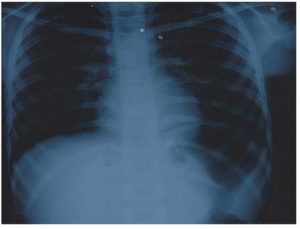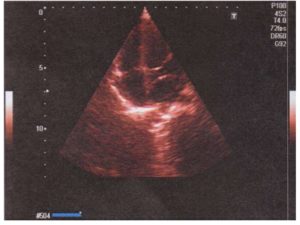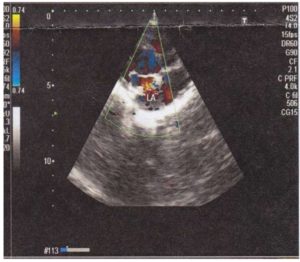In the early studies the incidence of congenital heart disease (CHD) is about 4 to 5 per 1000 live births. But this figure has been rising steadily until recently when incidence of 12 to 14 per1000 live births, or higher has been observed.1 The reasons for the early lower incidence rates of 4 to 5 per 1000 live births is that only the most severely affected subjects were referred to a cardiac center. Isolated ventricular septal defect (VSD) are by far the most common form of CHD.1 In a study by Khalil et al ., VSD and patent ductus arteriosus (PDA) were the commonest lesions in 34.8% to 18.6% respectively.2
Cor triatriatum is among the rarest of all congenital cardiac anomalies accounting for 0.1%-0.4% of CHD.3,4 In cor triatriatum the left atrium is divided by a fibro muscular membrane in to two distinct chambers: a posterior-superior chamber receiving the four pulmonary veins and an anterior-inferior chamber (true left atrium) that connects to the left ventricle by means of mitral valve.5
This lesion is usually symptomatic during childhood (symptoms of left heart obstruction or arrhythmia). A minority of individuals present in adulthood, when the diagnosis is made incidentally.6
We report a case a patient who was hospitalized for treatment of viral hepatitis but she was incidentally diagnosed as having associated cor triatriatum. So, we felt interested to publish this rare case.
Case
A 7 years old girl of 15 kilogram weight was admitted in pediatric ward of a medical college hospital with the complaints by the attendant of low grade irregular fever and palpitation since birth, right upper abdominal pain for 15 days, and yellow coloration of sclera and urine for 8 days. She also had weakness and poor effort tolerance. Her stool color was normal and there was no history of blood transfusion. She was from a lower middle class family and fully immunized. There was no history of chest pain and breathlessness. On examination of the girl she was moderately icteric, not anemic, pulse was 100 per minute, blood pressure was 90/70 mm of Hg. Temperature was normal. There was tender hepatomegaly. We examined the cardiovascular system and found regular pulse, visible apex beat. Apex was situated 4 cm apart from the midsternal line in the left 4th intercostals space medial to the midclavicular line. There was palpable P2. Second heart sound was found loud in the pulmonary area. There was soft systolic murmur in the mitral area with no radiation, other systemic examination revealed normal. Provisionally the case was diagnosed as congenital heart disease with hepatitis (Viral). Following investigation was done. X-ray chest A/P view was normal (Fig.-1). Total leucocyte count was 14000/cumm, Neutrophil/Lymphocyte/Eosinophil/Monocyte — 50/41/08/01 percent. ESR (Erythrocyte Sedimentation Rate) — 30 mm in the first hour, hemoglobulin percentage — 11.1 gm/dl, Serum Bilirubin — 5.4 mg/dl, SGPT -310 iu/L. HBsAg —Negative, Anti HCV- Negative, ASO titer 200 u/ml, urine for routine examination — normal. ECG showed sinus tachycardia with left atrial hypertrophy (Fig.-2). Color Doppler Echocardiography was done and found cor triatriatum with left atrial enlargement (Fig.- 3 & 4). Finally, the case was diagnosed as CHD (cor triatriatum) with acute viral hepatitis. Patient was treated for acute viral hepatitis and referred to the pediatric cardiologist for better management.
Cor triatriatum is a rare congenital anomaly with female preponderance of 1.5:1.7 Our case was also a girl of 7 years age. In a study by Alphonso et al., it was observed tachypnoea in 22, failure to thrive in 12, poor feeding in 6, shock in 4, cyanosis in 3, respiratory arrest in 2 and increasing lethargy in 1 among 28 patients of cor triatriatum. Four patients (14%) were incidentally diagnosed as cor triatriatum.8 This case was also diagnosed incidentally while presenting as viral hepatitis. Only associated complaints such as palpitation and failure to thrive were observed in our case. On examination we found loud 2nd heart sound with palpable P2. There was soft systolic murmur in the mitral area. The patient was not diagnosed to have cor triatriatum until 7 years of age, because her pulmonary venous obstruction was not severe.
The three main embryological theories explaining the development of cor triatriatum are malseptation, malcorporation, and entrapment.8 It may result from incomplete incorporation of the common pulmonary vein in to left atrium , abnormal overgrowth of septum primum,3,9entrapment of common pulmonary vein by the left horn of the sinus venosus preventing its incorporation in to the left atrium3 or persistence of a left sided superior vena cava which may impinge on the left atrium, resulting in the formation of an abnormal membrane.9 The most frequent cardiovascular abnormalities associated with cor triatriatum sinister in adult are usually related to the spectrum of left heart obstruction,7 mitral regurgitation and supravalvular annulus,7,9 and PLSVC ( Persistent Left Superior Vena Cava) draining in the coronary sinus.7 Other abnormalities are ostium secondum atrial septal defects, less commonly aortic regurgitation with dissecting aneurysm (bicuspid aortic valve?)7 and anomalous partial pulmonary venous return 7,9 other associated anomalies are the unroofed coronary sinus with a left superior vena cava joining the left atrium, ventricular septal defect, coarctation of aorta, tetralogy of fallot and rarely asplenia and polysplenia.10 Our case had no other associated cardiac and non cardiac anomalies.
The diagnosis is usually established by 2D TTE (Transthoracic Echocardiography) color flow mapping usually demonstrates increase in velocity and turbulent flow suggesting obstruction that can be assessed by continuous wave Doppler through the membrane.9 Transesophageal echocardiography is superior to TTE to diagnose cor triatriatum, providing better imaging of the left atrium, left atrial appendage, morphology of the dividing membrane and the degree of obstruction.6 In our patient 2D M Mode Doppler TTE was abnormal with septum and enlargement in the left atrium but there was no other anomalies observed.
Conclusion
Cor triatriatum may be asymptomatic and diagnosed incidentally. Every patient who has palpitation and failure to thrive should have thorough cardiologic evaluation to find out the rare cardiac abnormalities and managed accordingly. If not detected early there might be left heart obstruction leading to left heart failure and morbidity / mortality.
References
Hoffman JIE, Samuel K. (2002) “The incidence of Congenital Heart Disease”, JACC 39(12) 1890-1900.
Publisher – Google Scholar
Khalil A, Aggarwal R, Thirupuram S, Arora R. (1994) “Incidence of congenital heart disease among hospital live births in India”, Indian Pediatrics 31 519-27.
Malik A, Fram D, Mohani A, Fischerkeller M, Yekta A, mohyuddin Y (2008) “Taub Co-triatriatum: a multimodality imaging approach” C Can j Cardiol 24(3) e 19-20.
Bassareo PP, Tumbarello R, Mercuro G (2010) “Cor triatriatum lipomatous hypertrophy of the interatrial septum in the elderly; a case report” Cardiovasc Ultrasound 9 8-4.
Rorie M, Xie GY, Miles H, Smith MD (2000) “Diagnosis and surgical correction of cor triatriatum in an adult: combined use of transesophageal echocardiography and cathetirazation” Cathet cardiovasc Interv 51 83-6.
Righab Hamdan, Nicolas Mirochnik, David celermajer, Pierre Nassar, Laurence Iserin (2010) “Cor Triatriatum Sinister diagnosed in adult life with three dimensional transesophageal echocardiography” BMC Cardiovascular disorders 10(54) 1-4.
Chieh-Shou Su, Tsai-Chen, Wei-Wen Lin, Tain Lee, Ting Chih-Tai, Kae-Woei Liang (2008) “Usefulness of multidetector-row computed tomography in evaluating adult cor triatriatum” Tex Heart Inst J 35 349-51.
Alphonso N, Norgaard MA, Newcomb A, d’Udekem Y, Brizard CP Cochrane A (2005) “Cor Triatriatum: Presentation, Diagnosis and long-Term Surgical Results” Ann Thorac Surg 80 1666-71.
Publisher – Google Scholar
Thakrar A, Shapiro MD, Jassal DS, Neilan TG, King ME, Abbara S (2007) “Cor triatriatum: the utility of cardiovascular imaging” Can J Cardiol 23(2) 43-5.
Publisher – Google Scholar
Kokotsakis J, Anagnostakou V, Almpanis G, Paralikas L, Nenekidis L, Kratimenos T, Prapa E, Tragotsalou N, Lioulias A, Mazarakis A (2011) “Cor triatriatum presenting as heart failure with reduced ejection fraction: a case report” JCTS 6(83) 1-4.







